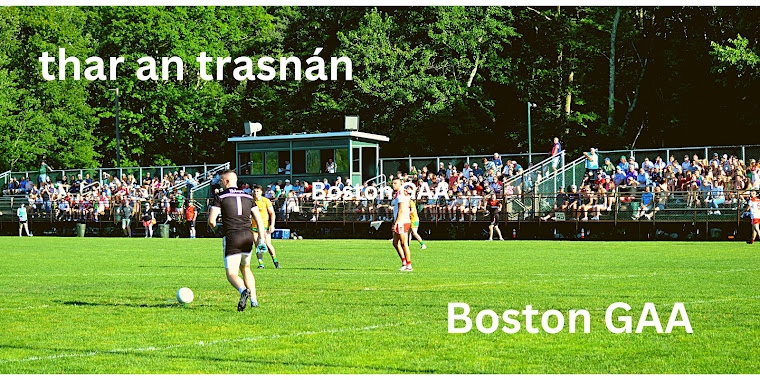As human beings we evolve.
Humans are taller, stronger, and live longer nowadays compared to a
generation or two ago. Along with
evolution of the species, training and fitness programs have evolved, making naturally
taller and stronger athletes even fitter and stronger today compared to 15 or
20 years ago. The games we play must
also evolve with the athletes who play them.
 |
| The 13-a-side game in North America is an open and fast version of Gaelic Football. |
Much has been said and written about the defensive tactics
employed by a number of county and club football teams lately. Pat Spillane’s “Puke football” was one of the
early descriptions of said tactics. Joe
Brolly referred to the recent Dublin versus Derry National League game as “muck.” I have watched some of the intercounty games
from Ireland in recent years and I have to say that at times the game resembles
basketball or Olympic handball played on a large field. The team not in possession retreats en masse
to defend the goal while the team with the ball passes back and forth across
the field several times before deciding to attempt a penetrating pass. I do not always remember it being that way;
my memory is of the ball moving up and down the field fairly quickly rather
than side to side.
Anyway, changing rules to suit the changing times is nothing
new. Basketball is a great example. Rules were introduced to keep dominant
players from completely taking over games.
The 3 second rule to prevent a particularly tall player from camping
under the basket, or rules for free throws to prevent said taller than tall
players from leaning towards the basket and reducing the distance.
What seems to have happened with Gaelic football has as much
to do with fitness and stamina levels as with tactics. In the “old” days players would not have been
fit enough to rush up and down the field to clog the defence or break away for
70 minutes the way they can now. As a
manager, if your players have the ability to execute the tactics why not use
them?
I am more used to watching the 13-a-side game played under the
North American County Board rules. It
has been that way since I came the United States 23 years ago. I do not know the reason for playing
13-a-side, I always put it down to the fact that we played on a small
field. Maybe it was down to numbers, who
knows. Anyway, since moving to the full
size field the numbers have remained the same and the games are highly
entertaining. Four less players on the
field means more space and managers have to vary tactics. Forwards have more room in which to operate
and games are open and fast.
It would be a radical change; maybe the powers that be would
have to wait until there is a crisis (which there is no sign of just yet)
before contemplating such a radical change.
Radical changes are not unprecedented in the GAA however. At one time games were played with 21 players
on each team, goals counted for an infinite number of points, frees and
sidelines had to be taken off the ground, etc.
However, if these tactics continue and lead to a decline in attendances
and viewership opening up the game by reducing the number of players would be
an option that is worthy of a high place on the list of considerations. Canton on a Sunday in high summer is evidence
of that.
By Rory O'Donnell

No comments:
Post a Comment